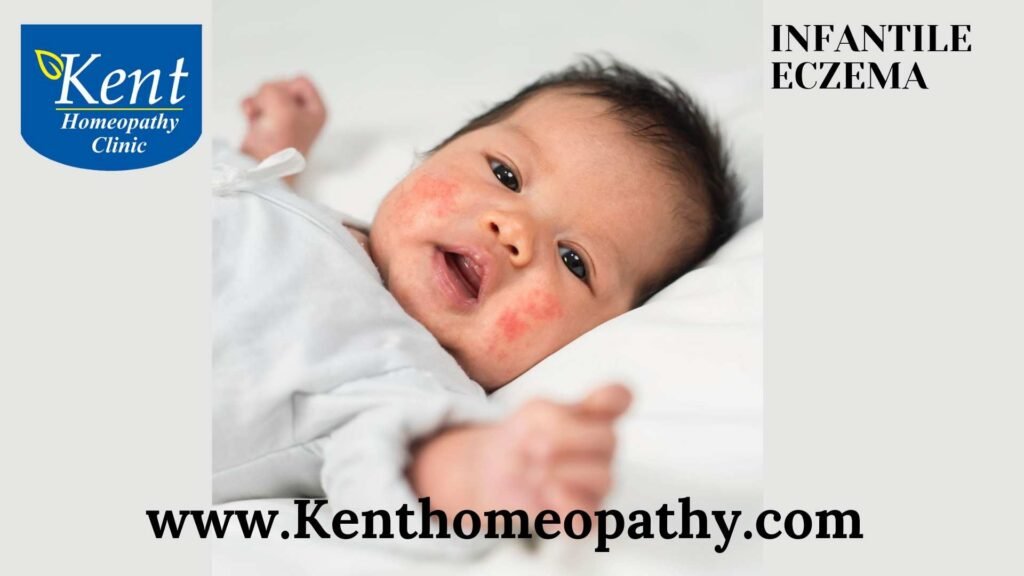Infantile eczema

Infantile Eczema: Unraveling Symptoms, Causes, and Types
Infantile eczema, also known as atopic dermatitis, is a common skin condition affecting infants and young children. Characterized by red, itchy rashes, this condition can be distressing for both infants and their parents. Understanding the symptoms, causes, and types of infantile eczema is crucial for effective management and care.
Symptoms:
- Red, Inflamed Skin: The hallmark symptom of infantile eczema is red, inflamed skin. This often appears in patches on the face, especially the cheeks and forehead, but can also affect other areas of the body.
- Itching: Intense itching is a characteristic feature. While infants may not be able to express their discomfort verbally, persistent scratching, fussiness, or disturbed sleep can be indicators.
- Dry and Scaly Skin: Affected areas may exhibit dryness and scaliness, leading to a rough texture on the skin surface.
- Oozing and Crusting: In severe cases, the skin may ooze clear fluid and develop crusts, especially if the affected areas are scratched repeatedly.
- Thickened Skin: Chronic scratching can result in thickened skin, known as lichenification, particularly in areas where the rash is persistent.
- Affected Areas: Common sites of involvement include the face, neck, hands, elbows, and the back of the knees. However, infantile eczema can occur on any part of the body.
Causes:
- Genetics: A family history of eczema, asthma, or allergic rhinitis increases the likelihood of an infant developing eczema. Genetic factors play a significant role in the predisposition to atopic conditions.
- Immune System Dysfunction: Infantile eczema is associated with an overactive immune response to irritants or allergens. The skin barrier in individuals with eczema may not function properly, making the skin more susceptible to inflammation.
- Environmental Factors: Exposure to environmental triggers, such as harsh soaps, detergents, or certain fabrics, can contribute to eczema flare-ups. Changes in temperature or humidity may also impact the skin.
- Allergens: Infants with eczema often have sensitivities to common allergens like certain foods, dust mites, pet dander, or pollen. Identifying and avoiding these triggers is essential in managing the condition.
- Skin Barrier Deficiency: In some cases, infants with eczema may have a compromised skin barrier that allows moisture to escape, leading to dryness and susceptibility to irritants.
- Infections: Bacterial, viral, or fungal infections can exacerbate eczema symptoms. Scratching the affected areas can create openings in the skin, providing an entry point for microbes.
Types:
- Acute Eczema: Characterized by sudden onset and intense inflammation, acute eczema often presents with red, weeping, and crusted lesions. It can be triggered by irritants or allergens.
- Subacute Eczema: This phase represents a transitional stage between acute and chronic eczema. The inflammation is less intense, and the skin may be dry, scaly, and exhibit less oozing.
- Chronic Eczema: In chronic eczema, the skin becomes thickened and lichenified due to prolonged inflammation and persistent scratching. This stage often requires ongoing management.
- Contact Dermatitis: In some cases, eczema may be triggered by contact with specific substances, leading to contact dermatitis. Identifying and avoiding these triggers is crucial in managing this type of eczema.
- Nummular Eczema: This type is characterized by coin-shaped patches of irritated skin. It can be more challenging to manage and may require specific treatment approaches.
- Seborrheic Eczema: Often seen in infants, this type primarily affects the scalp, leading to cradle cap—a condition marked by yellow, greasy scales on the scalp.
Contact to know more
Contact
Powai: 52, Galleria Mall,
Central Avenue, Hiranandani Gardens,
Powai, Mumbai-400076
Mobile Number: 08291492566
Timings
Monday to Saturday:
11:00 AM to 02:30 PM
06:30 PM to 09:00 PM
